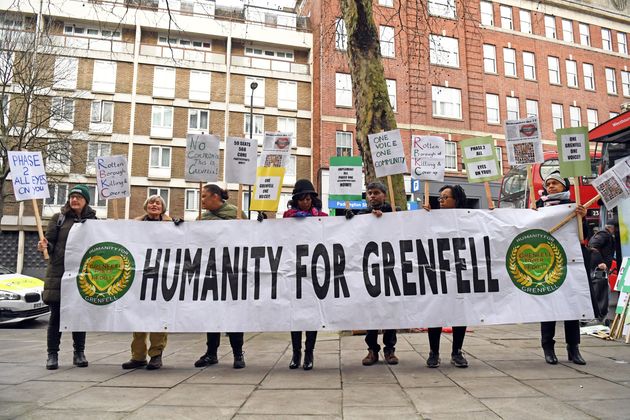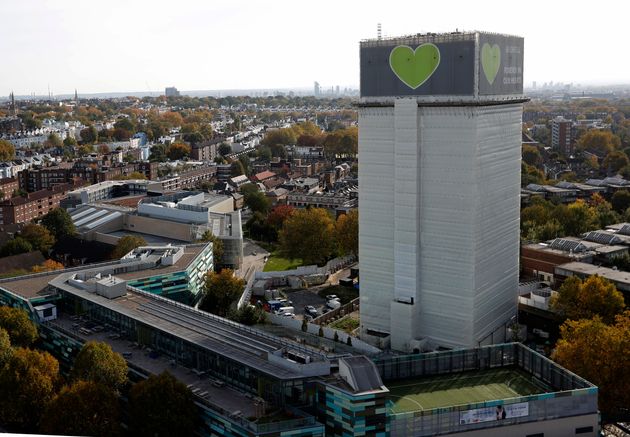It’s two-and-half years since the Grenfell Tower disaster that saw 72 people killed – and this week was notable for the scrutiny faced by companies heavily criticised in its aftermath.
The second phase of the official inquiry into the tragedy began on Monday, with the focus this time on why cladding panels made of flammable aluminium composite material (ACM) were fitted to the building.
The material has been blamed for the rapid spread of the blaze and questions have been raised, among others, about why the cheaper option (£454,000 was saved on a £9.2mn refit) was chosen.
The background
The 23-storey tower, owned by the west London borough of Kensington and Chelsea, was destroyed on the night of June 14, 2017, in Britain’s worst fire in a residential building since the Second World War.
In its first phase, now complete, the public inquiry led by retired judge Martin Moore-Bick examined in forensic detail the sequence of events on the night of the blaze.
Built in 1974, the tower was extensively refurbished between 2012 and 2016, most significantly when ACM cladding, specifically Reynobond PE, was wrapped over its concrete exterior.
The first part of the inquiry found this was the “principal” reason for the rapid spread of flames.
What is the second phase about?
The second phase will consider how the high-rise block came to be covered in flammable cladding and the events in the years leading up to the fire.
Witnesses scheduled to give evidence include representatives from the architects, contractors and sub-contractors who carried out the refurbishment, and from the makers and sellers of the cladding.
The main contractor in charge of the refurbishment was the privately-owned British firm Rydon Maintenance Ltd. The cladding suppliers included a French subsidiary of the US firm Arconic Inc, while the makers of the insulation material used as part of the cladding system were Celotex Ltd, a British subsidiary of France’s Saint-Gobain.
In the first four days of phase two, which is likely to continue for months, corporations were accused of shirking responsibility, criticised for appealing for immunity and condemned for “killing […] in pursuit of money”. Here are some of the most striking moments.
‘A merry-go-round of buck-passing’
The return of the inquiry was marked by claims that corporate companies were pointing the finger at each other without accepting any blame, despite experts saying their work failed to meet building regulations. Or, as counsel to the inquiry Richard Millett QC put it, there was a “merry-go-round of buck-passing”.
Millett said that, out of all the bodies involved in the refurbishment, only the local council – which commissioned the Grenfell refit – had admitted any failings. Architects, contract managers and main contractors were accused of evading responsibility.
Lead refurbishment architect Studio E said it “did not have any knowledge that the products used on the tower were unsafe”. In mitigation, it said product manufacturers had “produced materials and testing data which had the effect of misleading designers to consider that their products were safe”.

Rydon also blamed others. It alleged the providers of the cladding and insulation, Arconic and Celotex, had misled buyers into believing their products were safe for use on high-rises despite appearing to know of the dangers.
An internal Celotex email from November 2013 was read out that seemed to show officials knew using the insulation CelotexRS500 alongside ACM cladding could be dangerous.
Cladding subcontractor Harley Facades said it did not choose the materials but had “confidence” in the use of Reynobond – the type of ACM cladding used –after it did not ignite during a previous fire in 2012 at the Chalcots estate in Camden, which it refurbished five years beforehand.
Millett said: “Any member of the public reading those statements and taking them all at face value would be forced to conclude that everyone involved in the refurbishment of Grenfell Tower did what they were supposed to do and nobody made any serious or causative mistakes.
“All core participants who played a material part in Grenfell Tower have laid out a detailed case that it relied on others and how in no way was the work it did either substandard or non-compliant [with building regulations].
“In every case, what happened was, as each of them would have it, someone else’s fault.”
Dangers were known two years earlier – claim
On day two, the inquiry heard the main designers, contractors and fire safety consultants appeared to know two years before the disaster that a planned cladding system would fail if exposed to fire.
Rydon, Harley Facades, Studio E and fire inspector Exova were alleged to have known the proposed cladding would burn and fall off if exposed to external flames.
The email exchanges were introduced to the inquiry by Craig Orr QC, counsel for Celotex, which supplied the insulation used in the renovation of the 24-storey block. They arose as a result of a debate with building control about whether cavity barriers or fire-stops were required, he said.
In an internal Exova email on March 31, a Mr Pearson sent a message to a Mr Ashton, saying if “significant flames are ejected from the windows, this would lead to failure of the cladding system…”.
In another message, a Mr Crawford of Studio E was told by Mr Ashton of Exova that: “It is difficult to see how a fire-stop would stay in place in the event of a fire where external flaming occurred as this would cause the zinc cladding to fail.”
In his reply, Mr Crawford said: “This was my point as well – metal cladding always burns and falls off, hence fire stopping is usually just to the back of the cladding line.”
Mr Crawford looped Mr Lawrence, of Rydon, into the correspondence, with Mr Lawrence replying: “Excellent. That looks positive,” according to a statement submitted to the inquiry.
Earlier, in Harley Facades internal messages, managing director Ray Bailey was told by Daniel Antekell-Jones: “There is no point in ‘fire stopping’, as we all know; the ACM (aluminium composite material) will be gone rather quickly in a fire!”
In a statement, Celotex counsel Mr Orr said: “Whilst expressed in slightly different terms, the substance of what each of Harley, Studio E, Exova and Rydon was openly acknowledging in the above emails was that the cladding would fail in the event of a fire with external flaming.”
He said the “absence of any investigation of the fire safety risks of Reynobond PE panels” was “all the more striking” in the context of the exchanges.
Exova earlier said criticism of it is “unjustified” because it was not consulted about the combustible materials that eventually coated the building.
Arconic, which made the cladding, said: “It was the responsibility of others to decide whether or not to choose that product for a particular project.”

A ‘reprehensible’ bid for immunity
In a last-minute legal bid, witnesses from companies involved in coating Grenfell Tower in flammable materials suggested they would refuse to answer questions unless they were guaranteed immunity from prosecution.
An 11th-hour application was lodged asking chair Sir Martin Moore-Bick to write to the Attorney General asking for an undertaking that would stop any evidence staff gave being used against them in any future criminal proceedings.
Without the pledge, the hearing was told many would refuse to answer questions by claiming privilege against self-incrimination.
The application was made on behalf of firms including Harley Facades, Rydon, and Studio E.

Scotland Yard is conducting its own investigation into gross negligence manslaughter, corporate manslaughter and health and safety offences and said in September it had so far completed 17 interviews.
There were groans from survivors and victims after Sir Martin revealed the request, and Michael Mansfield QC, representing victims, said the move was “highly reprehensible and highly questionable”.
The next day they were also accused of trying to “sabotage the inquiry”.
The Justice4Grenfell group branded the move “disgusting” and Unite the Union said it would be a “mockery of justice” if it was granted.
Sir Martin said he would hear representations regarding the matter on Monday morning.
Jonathan Laidlaw QC, for Harley Facades, said four staff from the company had been interviewed under caution by Scotland Yard over alleged potential breaches of the Health and Safety at Work Act 1974.
Firms accused of killing victims in ‘pursuit of money’
A lawyer for the victims slammed an “epidemic” of incompetence around fire safety in the tower block, and accused companies involved in the refurbishment of being responsible for the deaths.
Sam Stein QC, for one group of victims, told the hearing: “The companies responsible killed those 72 people as sure as if they had taken careful aim with a gun and pulled the trigger.
“Those companies responsible killed when they criminally failed to consider the safety of others.
“They killed when they promoted their unsuitable, dangerous products in pursuit of money and a place within the market, and they killed when they ignored that ultimate client – the people of Grenfell Tower.”
In particular, the suppliers of the combustible insulation and cladding panels, Celotex and Arconic respectively, were attacked as displaying an “extraordinary degree of contempt” for residents’ safety by marketing their flammable products.
Stephanie Barwise QC, for another group of victims and survivors, said Celotex targeted the building as a “flagship” project for its RS5000 insulation, and cynically exploited what one of its bosses called “the smoke of confusion” around building regulations.
It actively promoted the material despite senior executives knowing it should have been recalled after safety tests, she claimed.
In an email exchange between Celotex and one of its distributors, the firm’s head of technical, Rob Warren, wrote it was “clearly wrong” when an inspector “said it was OK to use any insulation up to 18 metres (59ft), and only above 18 metres did it have to be non-combustible”.
He added: “The fire hasn’t got a tape measure and if it starts at the ground floor it will love to race up the first 18 metres. Just shows the smoke of confusion out there.”
The distributor, Martin Stearne at SIG Technical Services, replied: “Never has the expression ‘smoke and mirrors’ been more appropriate,” and added that “if specifically challenged” he would opt for a different product but “if I’m not challenged it’ll be RS5000″.
Barwise further said Arconic almost doubled its UK sales target for the dangerous cladding used on Grenfell in the years before the blaze after it was given the second-lowest fire safety rating in European tests.
The US conglomerate was accused of trying to offload its Reynobond PE cassette cladding in Britain after it was given a European class E rating, threatening sales on the continent in markets such as Spain.
An email exchange showed the Grenfell Tower project was one Arconic was “confident” it would secure, which Barwise said contradicted the firm’s position it was just a manufacturer that sold a product – saying its distributors “targeted potential contractors in projects”.
Its Reynobond PE panels featured a polyethylene core, which has a heat combustion akin to diesel and close to lighter fluid – and has a high-calorific value compared with other construction materials, Barwise said.
She criticised as “absurd” Arconic’s statement when it said “the tragedy at Grenfell Tower shows the awful consequences which can arise when combustible materials are used in a particular combination and configured in a particular manner”.
She said: “That is not what the fire at Grenfell shows. It shows that the use of a thermoplastic with a heat of combustion similar to lighter fuel within any construction is likely to result in an uncontrollable inferno… the dripping, burning droplets will set fire to anything in its path.”
The inquiry continues on Monday.